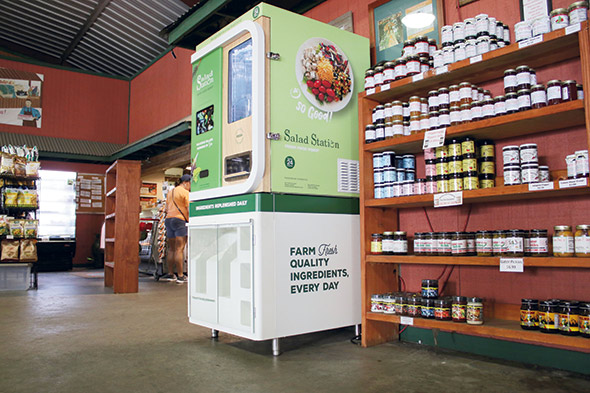Like many restaurant chains, The Salad Station has an ambitious expansion plan. But unlike other chains, The Salad Station continues to expand through the use of a robot — or more precisely, an automatic salad-making machine. The process starts when customers select their ingredient choices on a touch-screen on the front of the machine. Rotating canisters inside the machine then dispense the desired vegetables, dressing and toppings to produce a finished salad in a matter of seconds.
 Scott Henderson, CEO, The Salad StationThe robots are part of an expansion strategy that is enabling the chain to enter spaces that can normally be difficult to break into, such as hospitals and universities. The Salad Station already has roughly 20 robots in operation in Louisiana and has plans for a large-scale push into the Houston area that will add 100 robot salad-makers and 15 to 20 brick-and-mortar units within the next three years.
Scott Henderson, CEO, The Salad StationThe robots are part of an expansion strategy that is enabling the chain to enter spaces that can normally be difficult to break into, such as hospitals and universities. The Salad Station already has roughly 20 robots in operation in Louisiana and has plans for a large-scale push into the Houston area that will add 100 robot salad-makers and 15 to 20 brick-and-mortar units within the next three years.
Q: What’s driving The Salad Station’s decision to go beyond brick-and-mortar units with locations that leverage robotic salad-making technology?
A: The technology is what originally drove it. When we came across this technology, we actually looked at it to use inside of our brick-and-mortar stores — not for a salad robot but as a topping dispenser as part of our salad bars. We’ve always said that our concept would be good for nontraditional locations like hospitals and airports. We realized that this would be a perfect fit for our brand to expand into nontraditional locations. Obviously, getting into those locations is harder. But it’s much easier when it’s a 3-foot by 3-foot robot that plugs into any outlet.
Q: How do you see these machines helping to build your brand?
A: We thought our brand could overcome some of the [negative] thoughts about vending equipment. We never considered what the machine could do for the brand. We’ve realized that there’s some great marketing we can play off it. Being associated with state-of-the-art technology helps the appearance of our brand and shows that we’re always on the cutting edge.
Q: How will the fresh, local ingredient mantra that drives The Salad Station restaurants meld with vending machines?
A: The stereotype is that vending is not necessarily always fresh. We recently launched a new machine and I was on-site all day. By far, the number-one asked question was, “How often is it serviced?” When we operate one of these robots, we service it every morning and every afternoon — once before 10 a.m. and once after 4 p.m. for the late-night shift.
We have a reputation for fresh ingredients. Most people, when they saw the machine, they [knew] the brand spoke to freshness, so that took some of the stereotype out of it. If our brand wasn’t on the machine, it would be more of a concern.
 The Salad Station plans to add 100 automatic salad-making machines in the Houston area within the next three years.
The Salad Station plans to add 100 automatic salad-making machines in the Houston area within the next three years.
Q: Are you concerned that the machines might take business away from your brick-and-mortar stores?
A: There is a difference. This robot is available 24 hours a day, but it only has 18 ingredients. Our restaurants have 150 toppings. So, although it’s the same freshness, it’s a different experience. We’re using this as brand exposure as well. I’m surprised at how many [machine users] have never been to The Salad Station and this is [an opportunity] for them to come into a traditional unit after their visit to an automated The Salad Station and experience the concept on a larger scale.
Q: How are you stocking the vending stations?
A: Right now, food is prepped either at a The Salad Station restaurant or a commissary kitchen. In Houston, we will have two commissaries to service multiple robots. All products are prepped and put into airtight canisters. When you go to the machine to service it, the original canister is removed and the new canister put in. Once you leave the restaurant or commissary kitchen, no food is ever touched.
Q: What metrics will you use to gauge the success of the machines?
A: We consider anything over 25 salads a day (in a 24-hour time period) as successful. All of our contracts give us an exit clause for underperforming robots. The newest robots we’re going to be deploying will actually have wheels on them. We’re deploying a robot at a university and, if it underperforms in a certain area, we will probably relocate
it [elsewhere] on the campus.
Q: What have you learned from the installations so far?
A: You’ve got to be somewhat patient. There’s a learning curve. Just like with any technology or any computer, there are constant upgrades. This whole world of technology is changing so fast that it looks like next year — or the year after or five years from now — it’s going to be a lot different. You’ve got to have an open mind. Because we are willing to change and keep embracing new technology, it’s been successful so far.



